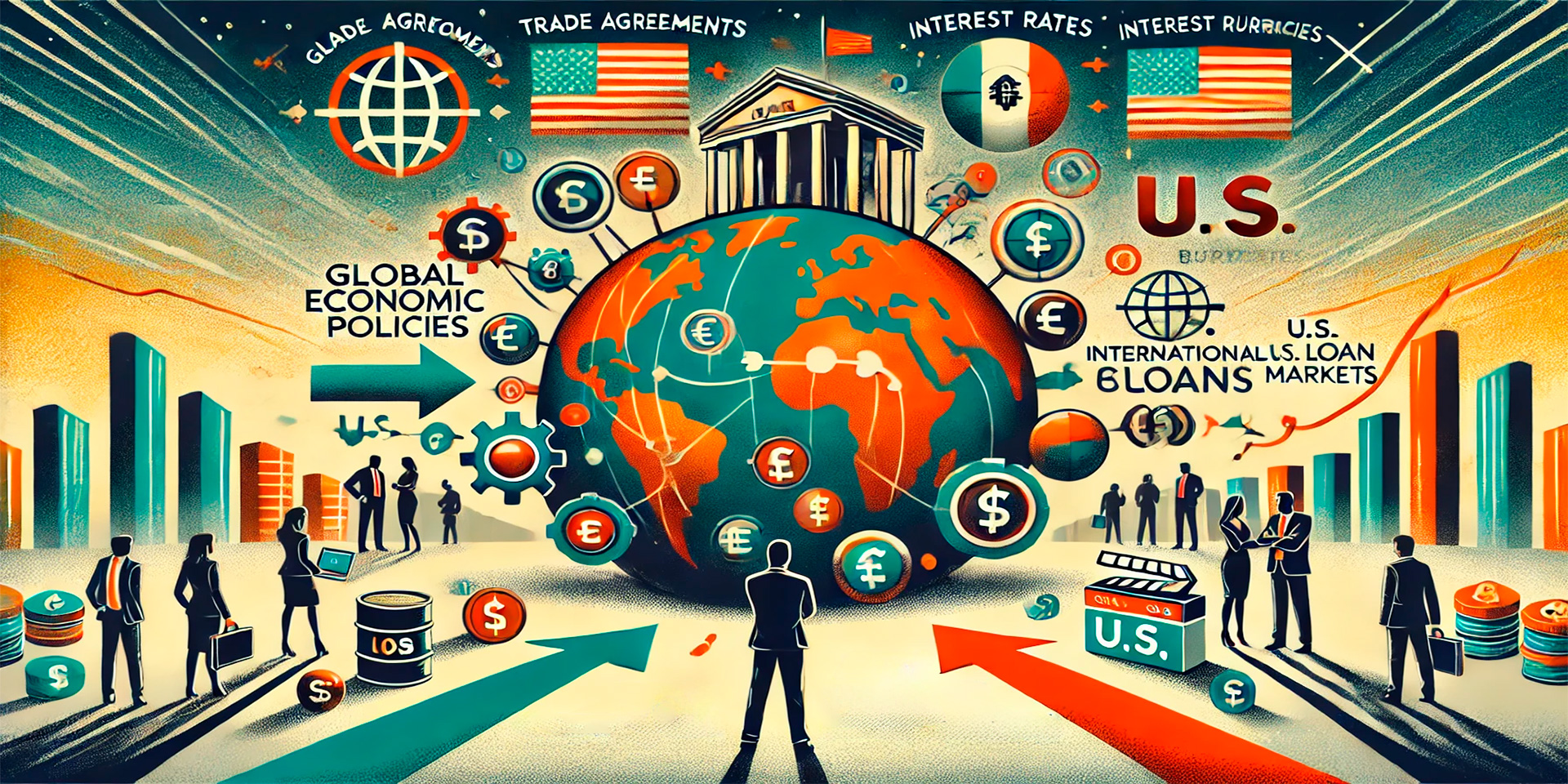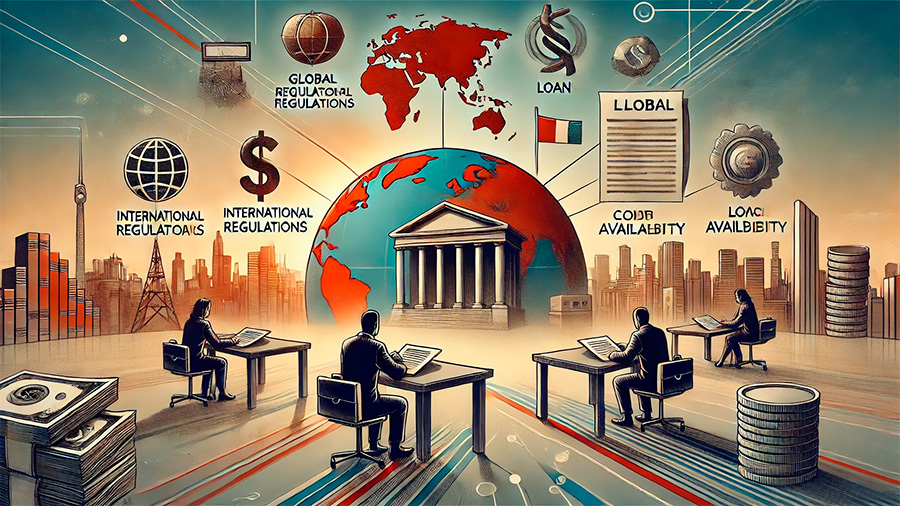
How Global Economic Policies Shape U.S. Loan Markets: What Borrowers Need to Know
International economic policies have a significant influence on the U.S. loan market, affecting everything from interest rates to loan availability. Global decisions, such as trade agreements, monetary policies, and regulations from international bodies, can shape the environment in which American borrowers seek credit. As the global economy becomes more interconnected, shifts in international policies are increasingly affecting U.S. businesses and consumers.
Understanding how these global factors influence loan markets in the United States is crucial for borrowers and financial institutions alike. By staying informed about international economic trends, U.S. businesses and individuals can better navigate the changing landscape of borrowing.
Global Monetary Policies and U.S. Interest Rates
One of the most direct ways international policies impact U.S. loans is through global monetary policy. Central banks around the world, such as the European Central Bank (ECB) and the Bank of Japan, set interest rates that influence global credit markets. When these central banks adjust their rates, it creates ripple effects that extend to the U.S., affecting borrowing costs for businesses and consumers.
For example, if major central banks increase their interest rates to curb inflation, this can cause borrowing costs to rise globally, including in the U.S. This happens because global investors often shift capital between countries to seek better returns. When international interest rates rise, it becomes more expensive for U.S. financial institutions to access foreign capital, which can lead to higher loan costs for American borrowers.
In contrast, when global interest rates are low, U.S. borrowers may benefit from cheaper loans, as global capital flows into the U.S. market in search of better yields. However, this relationship can be complex, as domestic policies also play a significant role in determining U.S. interest rates.

The Influence of Trade Policies on U.S. Loan Markets
International trade policies also have a substantial effect on the U.S. loan market. Trade agreements, tariffs, and sanctions can alter the economic conditions under which U.S. businesses operate, indirectly influencing their access to credit. For instance, when the U.S. engages in trade wars or imposes tariffs on imports, it can disrupt supply chains and increase costs for American businesses. These added pressures can reduce profitability, making it harder for businesses to secure loans or pay back existing debts.
Additionally, changes in global trade policies can affect foreign direct investment (FDI) into the U.S., which in turn impacts the availability of credit. If international investors see the U.S. as a risky market due to shifting trade policies, they may reduce their investments, tightening the loan market. On the other hand, favorable trade agreements can boost investor confidence and increase the flow of foreign capital into U.S. financial markets, leading to greater loan availability and better terms for borrowers.
Foreign Exchange Rates and Loan Repayments
Foreign exchange rates, influenced by international economic policies, play a critical role in shaping the cost of loans for U.S. businesses with international operations. Companies that borrow in U.S. dollars but operate in other currencies are particularly vulnerable to fluctuations in exchange rates. When the value of the U.S. dollar strengthens relative to other currencies, it becomes more expensive for foreign borrowers to repay U.S. loans, as it requires more of their local currency to service dollar-denominated debt.
Similarly, U.S. companies that generate revenue in foreign currencies may face challenges if the dollar appreciates, reducing the value of their foreign earnings when converted back into dollars. This dynamic can affect a company’s ability to make loan payments and may even lead to higher default risks. On the other hand, when the dollar weakens, U.S. borrowers with international revenue streams may find it easier to service their loans, as their foreign earnings translate into more dollars.
Exchange rate fluctuations are often driven by global monetary policies, geopolitical events, and international trade dynamics. Businesses with international exposure must carefully manage currency risks when taking on loans in the U.S.

International Regulations and Loan Availability
Global regulatory frameworks also shape the availability of loans in the U.S. For example, international agreements on banking regulations, such as the Basel Accords, set standards for capital requirements and risk management that U.S. banks must adhere to. These regulations are designed to ensure financial stability but can also limit the amount of capital banks have available for lending.
In times of global financial uncertainty, international regulators may impose stricter capital requirements on banks, reducing their ability to issue new loans. This can tighten credit markets in the U.S., particularly for small businesses and consumers who rely on access to affordable loans. Conversely, when international regulators ease these requirements, U.S. banks may have more flexibility to increase lending, making loans more accessible.
Additionally, sanctions imposed by international bodies or individual countries can disrupt credit markets. For instance, sanctions against specific countries or industries can restrict U.S. companies’ access to international financial markets, making it harder to obtain loans or refinance existing debt. These sanctions may also lead to higher borrowing costs as lenders factor in the increased risks associated with restricted markets.
The Role of International Investment in U.S. Loan Markets
Foreign investment plays a key role in the U.S. loan market, with international investors providing significant capital to U.S. banks and financial institutions. When global economic policies encourage foreign investment in the U.S., it boosts the availability of credit, leading to more competitive loan terms for businesses and consumers. Conversely, when global investment flows shift away from the U.S., either due to geopolitical tensions or changes in international economic policies, the domestic loan market can tighten.
For instance, if foreign investors become wary of U.S. market risks or see better opportunities in other regions, they may pull capital out of U.S. banks. This reduction in available capital can lead to higher interest rates, stricter lending standards, and reduced access to loans. International economic events such as Brexit or changes in European Central Bank policies have, at times, influenced the flow of foreign capital into U.S. markets, demonstrating how closely tied U.S. loan availability is to global investment trends.
Conclusion
International economic policies have a far-reaching impact on U.S. loan markets, influencing everything from interest rates to credit availability. Global monetary policies, trade agreements, exchange rate fluctuations, and international regulations all play a role in shaping the cost and terms of loans for American businesses and consumers. By understanding how these global factors affect borrowing conditions, U.S. borrowers can make more informed decisions about managing debt and securing financing in a dynamic economic landscape.

